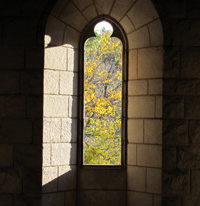Daily Office: Vespers
Hidin’
Tuesday, 11 January 2011
At the risk of being irritatingly jocular, that’s what we propose for Anthony Tommasini, if he carries out his threat to drop Haydn from his unnecessary and wrong-headed attempt to compile a “top 10” list of classical composers. Even if, in the process, he’s making useful observations right and left, cramming the essentials of what used to be called “music appreciation” into three paragraphs.
Haydn, who was widely celebrated during the 200th anniversary of his death in 2009, is often called the father of the symphony, as it came to be known. I’d throw in the father of the string quartet and the piano sonata. Haydn was a pioneer in figuring out how to write a sizable multimovement instrumental piece that sounded organized and whole, an entity. The system of sophisticated tonal harmony had developed to the point where a genius like Haydn could figure out how to process themes and manipulate major and minor keys to dramatic effect throughout the many sections of a long work.
Moreover, Haydn was the first great master of what is called motivic development, in which bits and pieces of music — a few notes, a melodic twist, a rhythmic gesture — become the building blocks for an entire symphony in several movements.
Haydn passed on this technique to his recalcitrant student Beethoven, who, for all his notions of having invented himself, was deeply indebted to Haydn. Beethoven took the technique of motivic development even further. If you were going to make a case for Beethoven as the greatest composer in history, you would base it on his ability to make a long work, like the “Eroica†Symphony, seem like a musical monument in motion. For all the episodic shifts and turns of this piece, as it plows through four dramatically contrasting movements, most of the music is generated from a handful of motifs that you hear at the beginning.
But be sure to watch the video in which Tommasini illustrates his notion that the rondo from K 311 reminds him of the back-and-forth between Susanna and Figaro. It’s delightful.

